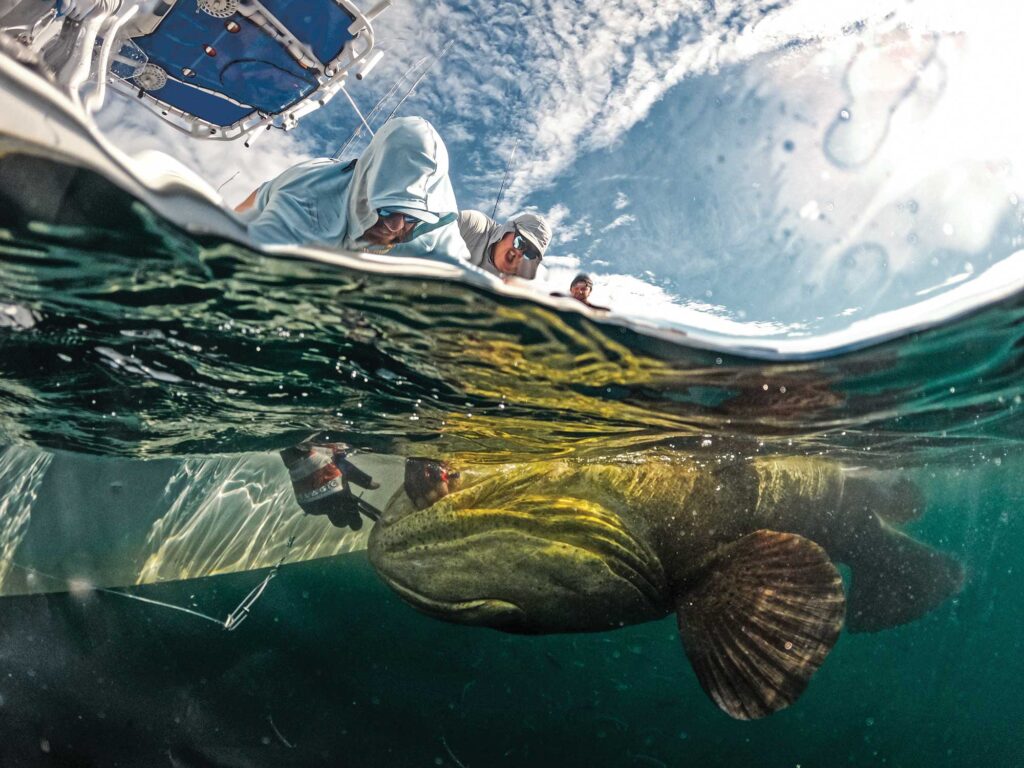
The action was fast and furious. My wife (then girlfriend) and I were visiting one of her friends in San Diego, and I suggested that we hop on one of the boats out of Point Loma for some fishing and wildlife viewing. We departed early and hit one of the inshore kelp beds. As soon as the baits hit bottom, they were attacked by the various species of rockfish, sand bass and others that call the California coastline home.
Unfortunately, a good portion of the fish caught by anglers on the party boat were undersize and had to be returned. But reeling them up from the depths had caused barotrauma, a pressure-related injury. Many had distended bellies and were unable to swim back to where they came from. They became easy fodder for the sea lions that patrolled the boat’s perimeter, picking off the floaters as they haplessly flapped at the surface.
Though these fish didn’t end up on a fillet table, their demise still negatively impacted the health of the fishery. It was scenarios like this that led to the creation of Return ’Em Right, an organization dedicated to “improving reef fish survival by equipping anglers with the knowledge and gear to confidently and successfully release reef fish.” To do so, the program has worked to educate anglers and provide solutions that help ensure the survival of released fish.
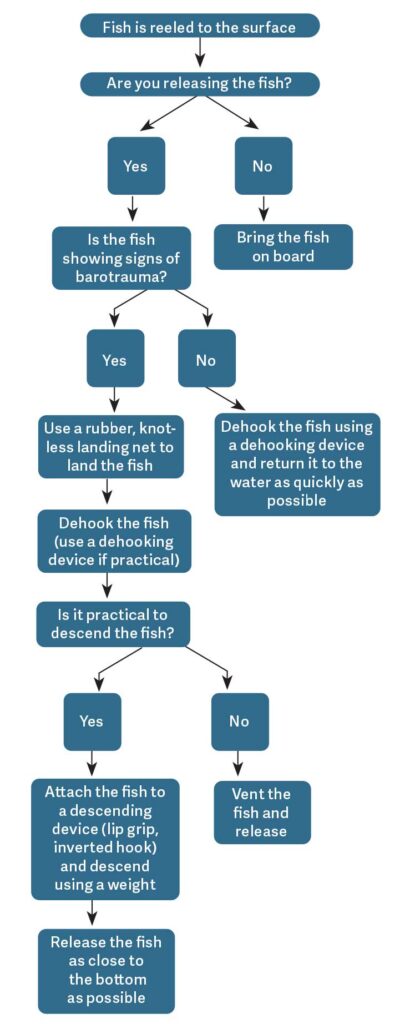
By learning and using best practices, anglers can significantly reduce the mortality of released fish and improve the overall health of the fishery. To give anglers an easy-to-follow series of guidelines to work with on the water, Return ’Em Right recently published the Best Release Practices Manual. It was developed in collaboration with private anglers, captains, scientists and fisheries managers.
You can help Return ’Em Right and your fellow anglers ensure the future of reef fisheries by following the guidelines in the Best Release Practices Manual. Some of the info might seem rudimentary to our readers, but the section on handling and releasing fish is an important read for everyone targeting snapper or other deep-dwelling fish. We have excerpted some of that section and hope you use that info the next time you target snapper or other deepwater fish.
Handling and Releasing Fish
An important decision point on a fishing trip is deciding what to do when a hooked fish is reeled to the surface. It is important to identify the fish as soon as possible, keeping in mind current bag limits, size limits and seasons, as well as how many of that species you already have in your possession. Don’t waste valuable time trying to figure out whether you can or should keep the fish. If you are going to keep the fish, the method for bringing a hooked fish onto the boat is not so important.
However, if you need to bring the fish on board because you are unsure if you can keep it:
- Do not gaff the fish. Rather, use a rubber, knotless landing net to land the fish.
- Have your measuring equipment available and ready beforehand. If you need to measure the fish, measure it on a wet surface.
- If possible, use wet gloves, or wet hands if no gloves are available, to handle the fish.
- Avoid placing your hands or fingers under a fish’s gills when lifting or holding down a fish to measure or vent it because this can damage the gills. Instead, use a lip grip device when handling fish.
- If the fish is gut-hooked, do not yank the hook out. Simply cut the line as close to the hook as possible.
If you plan to release the fish, take a moment to assess whether it is exhibiting signs of barotrauma. The two most important things to remember when releasing a fish are to minimize handling and get the fish back in the water quickly.
What to do if a fish is not exhibiting signs of barotrauma:
- Use a dehooking device to release the fish as quickly as possible. However, even if a fish taken from deep water is not showing signs of barotrauma, it can be helpful to descend the fish. This should only be considered if it can be done quickly.
Descending in the absence of evidence of barotrauma can be helpful for a couple of reasons:
- Barotrauma can be present even if external signs are not obvious.
- Releasing a fish close to the bottom can help reduce the risk that a predator will eat the released fish.
- Lip-attached descending devices can flush water over a fish’s gills and help the fish recover before it is released, which is similar to revival techniques used in inshore and freshwater fishing.
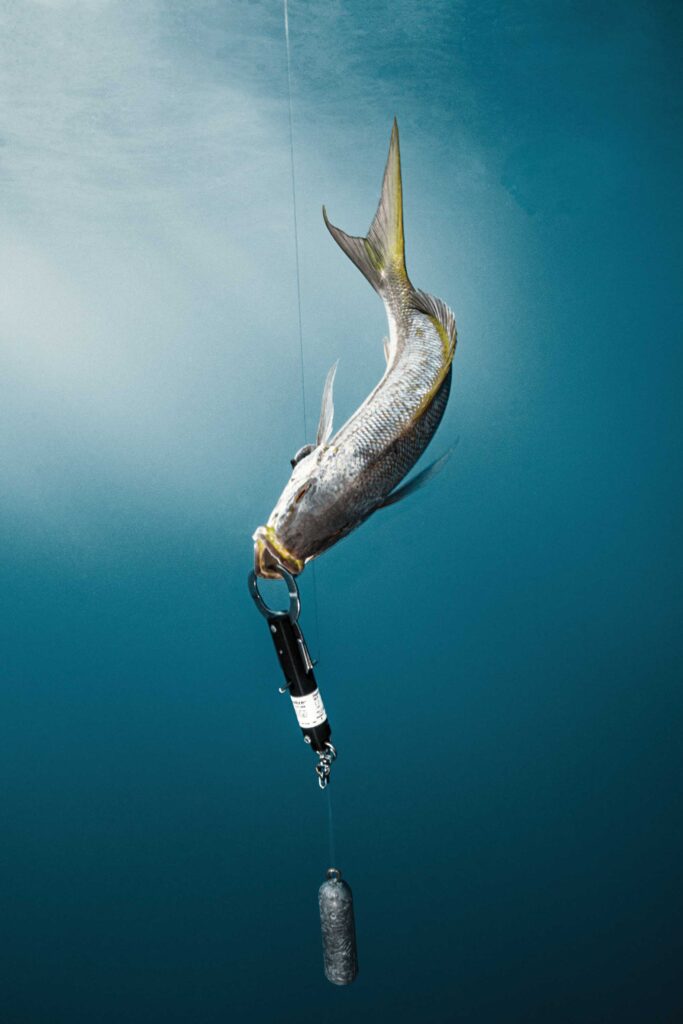
What to do if a fish exhibits signs of barotrauma:
- Dehook the fish using a dehooking device, when appropriate.
- Decide whether it’s more appropriate to vent or descend the fish. Note: You should not need to do both when using the proper amount of weight to descend.
When done properly, descending and venting can both increase survival upon release; however, descending is preferred because it is less invasive and promotes long-term survival of released fish.
If you decide to vent:
- Lay the fish on its side on a cool, wet surface.
- Lay down the pectoral fin, which marks the location to vent the fish (2 or 3 inches past the base of the pectoral fin).
- Follow the trailing edge of the pectoral fin and slide a sharp, hollow needle device under a scale at a 45-degree angle to pierce the fish’s swim bladder. Listen for a hissing sound, similar to the sound of a tire losing air.
- Once you hear the hissing sound, stop inserting the venting tool. Once the hissing sound stops, remove the needle and release the fish headfirst into the water.
Venting should be used when descending is not possible (for example, when too many anglers are on a boat or too many fish are being caught at the same time) and should only be done after proper training (available at returnemright.org).
If you decide to descend:
- Attach the fish to a descending device (lip grip, inverted hook, fish elevator, etc.).
- Descend the fish using a weight; 1 pound of weight for every 5 pounds of fish is a good rule of thumb.
- If practical, release the fish as close to the bottom as possible. This can increase the chance that the fish might be released near structure or a school of fish, providing additional protection from predators. If it’s less burdensome to release the fish midwater column, descend to at least 20 meters (66 feet) to improve survival.
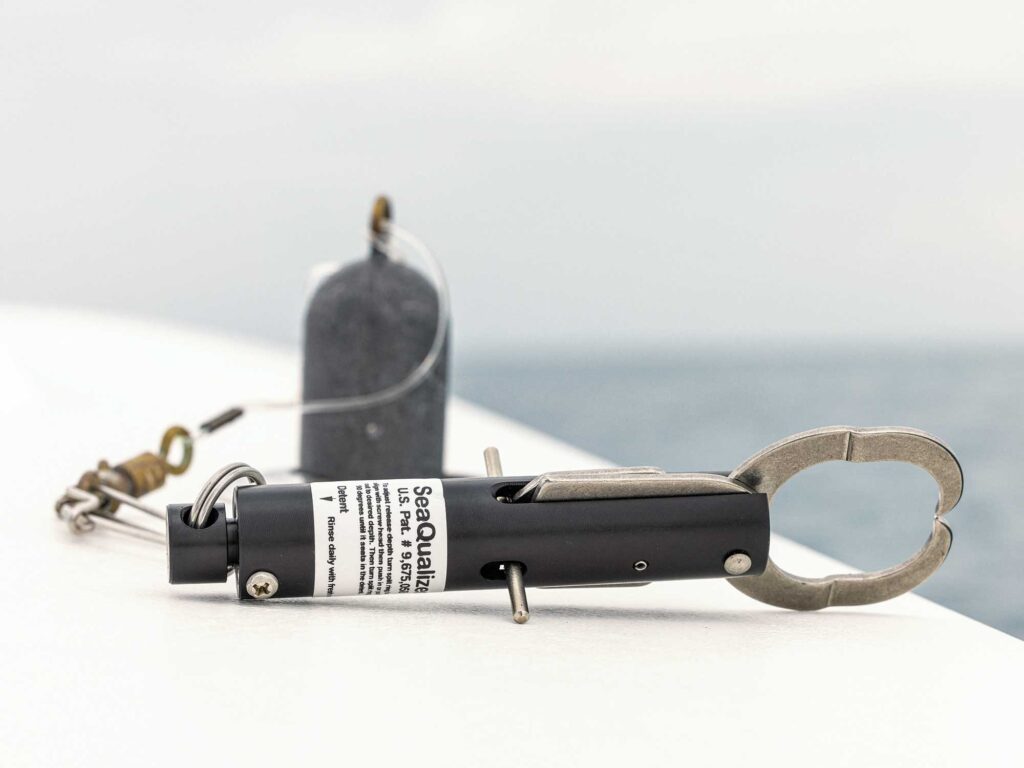
Descending Devices
Lip Grip Device
(e.g., SeaQualizer)
These devices clamp to a fish’s lower jaw. If the device is a pressure-release device, set the depth of release closest to the bottom (without surpassing bottom depth), and the fish will release automatically at that depth. If it does not have a pressure release, manually release the clamp by jerking up on the rod once the fish reaches the desired depth or the bottom.
Inverted Hook Device
(e.g., Shelton, Roy’s Fish Saver)
There are several different styles of inverted hooks that all work similarly. An inverted, barbless hook is inserted where the original hook hole was from reeling the fish up, or you can gently pierce the soft tissue under the fish’s lower jaw. Once the fish is dropped to the desired depth, you simply reel up, and the hook slides out of the fish’s mouth
Fish Elevator
Fish elevator is a general term used to describe descending devices made using weighted crates, baskets or cages. These weighted devices are capable of releasing multiple fish at a time. Consider having a multifunctional device such as a weighted crate that can be used to store gear and also release fish.
Since its launch in May 2022, Return ’Em Right has provided anglers in the Gulf states and beyond with educational resources and release aids that have ensured countless fish have been safely returned so they may be caught and released again. To date, the program has reached nearly 30,000 anglers. With the publication of the Best Release Practices Manual, the organization is sure to reach even more people and help even more released fish survive. Visit returnemright.org for the latest info, training, and even free release aids.
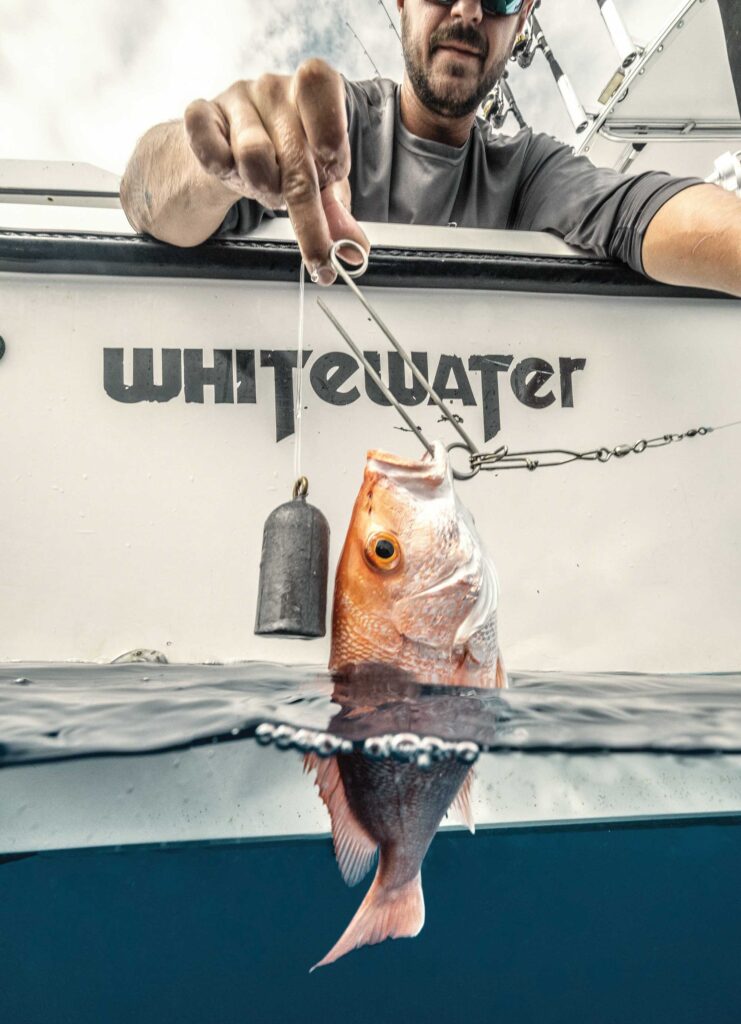
Choosing a Method
Descending Pros
- Less potential for injuring the fish.
- Documented reversal of barotrauma symptoms during descent.
- Quick descent can protect fish from predators by releasing them close to habitat.
Cons
- Time required to descend the fish
- Need for heavy weights and a dedicated rig.
Venting Pros
- Quick.
- Inexpensive equipment.
Cons
- Tools can clog or break easily.
- Injuring the fish is common due to incorrect placement or overinsertion of the venting tool.
- If not enough gas is released, the fish might not be able to return to depth.
- Inappropriate tools, including knives, ice picks and hooks, and the reuse of dirty tools can promote bacteria and infection.
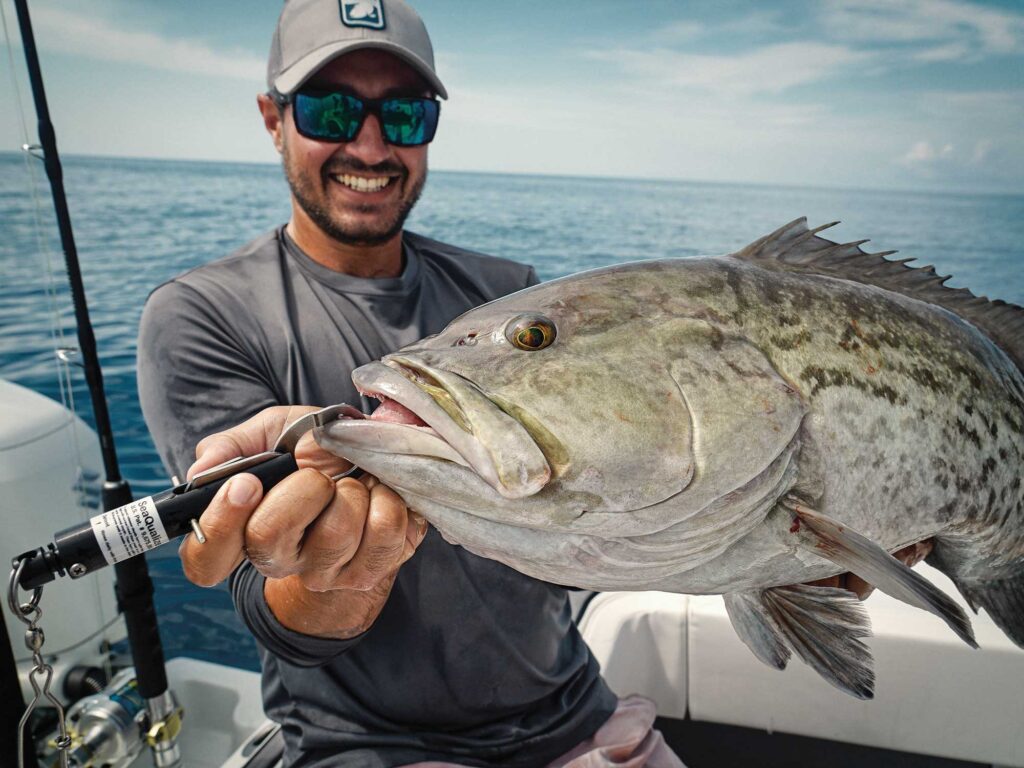
Want to Take a Picture?
Photographing fish on the boat should be done with care, with these best practices in mind:
- Do not insert your hands into the fish’s gills or eyes.
- Make sure your camera is ready beforehand, and try to keep the fish in the water to minimize stress while waiting for the camera if the camera is not quite ready.
- Keep fish-handling and release equipment nearby, rigged and ready for use.
- When appropriate, minimize handling or contact as much as possible by using a lip-grip-style device, such as a BogaGrip, to secure the fish’s head.
- As you remove the fish from the water, think about how long you can hold your own breath for judging how long the fish should be out of the water.
- Hold the fish horizontally, using a hand to support the fish’s abdomen.
- Take photos quickly, and consider only taking photos of fish you plan to keep.
- Consider limiting the sharing of photos of boat decks covered with fish (such as “meat haul” or “kill” shots).









